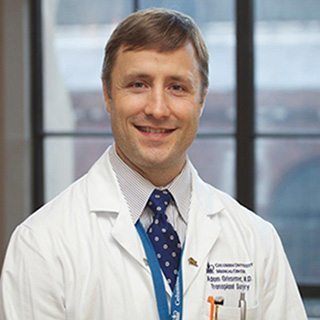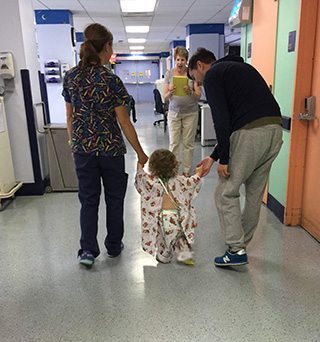A Living Donor’s Gift to His Adopted Daughter
Peter McKay donated part of his liver to Darcy. Now, when he looks at her scar, he sees a biological connection he never imagined.
First-time parents Peter McKay and his husband, Chris, noticed everything about their newborn daughter, Darcy: what made her smile, what made her fuss. Darcy liked “Twinkle, Twinkle, Little Star.” She didn’t like water in her face at bath time. She liked being swaddled, except for her toes; she’d always stick them out.
Before making the decision to adopt, they’d done their homework. They studied every parenting book on the shelf — new school, old school, and everything in between, Peter says. Since their adoption was open, they’d seen Darcy’s birth parents’ medical records. “Boring” is how a doctor described them.
So, when her skin had a yellowish color, they didn’t worry at first. Then, at Darcy’s two-month checkup, her doctor said the coloring, which indicated jaundice, wasn’t normal. She needed to see a liver specialist at NewYork-Presbyterian/Columbia University Irving Medical Center.
Darcy saw a liver specialist at the hospital the next day.
“We took that very seriously,” Peter says. “We knew — this is something that we need to figure out.”
A Rare Diagnosis
After tests ruled out any fast-moving conditions that would require an immediate liver transplant, Darcy was diagnosed with progressive familial intrahepatic cholestasis type 2 (PFIC2), a rare disorder. Symptoms usually begin in infancy. The condition can cause cirrhosis of the liver before age 2 and typically leads to liver failure within 10 years.
Among its important roles, a healthy liver cleans toxins out of the blood. Bile, which is a fluid created by the liver, moves processed substances into the intestines for elimination. But because of PFIC2, Darcy’s liver wasn’t expelling the bile properly. It was going into her bloodstream, which causes severe, body-wide itching.
“The doctor said, ‘Well, if she’s not [itching] now, expect it anytime,’” Peter says. “Then we were just waiting for it, we were looking for it.”
The scratching started gradually. Then, she was itchy all the time. Even with the special silk mittens she wore at night, she scratched her chin raw.
“Imagine every second of the day, including when (you’re) sleeping, feeling like you’re itching and there are bugs under your skin,” Peter says. “That’s really what she felt like for her first couple of years.”
Tough Conversations
Around her first birthday, Darcy underwent a partial external biliary diversion surgery to alleviate the itching. But the surgery didn’t stop the problem. Darcy was taking several medications a day, none of which worked. She was still scratching.
When the word “transplant” came up, it was early on in the conversations about Darcy’s treatment, but it was always a “future word,” Peter says. As in, “sometime in her childhood she may need a transplant.” And then it was, “maybe by the time she’s 10.” And soon it was, “in the next of couple years.” And then, “I think we need to start thinking about transplant.”
Then the unthinkable: Peter and Chris started talking about how to continue if they had a child who died.
“Those conversations are almost impossible and unprecedented, and you could never imagine what that conversation is like until you’re actually in it,” Peter says.
Without a transplant, Darcy’s life expectancy was “on the order of years,” says Dr. Adam Griesemer, transplant surgeon at the NewYork-Presbyterian Center for Liver Disease and Transplantation and the principal investigator at the Columbia Center for Translational Immunology. “Her disease causes significant symptoms but only leads to cirrhosis after a few years,” Dr. Griesemer says. “However, the symptoms of bile salt accumulation in the tissues can be debilitating.”
I love the fact that her scar is in the shape of a peace symbol. I think that’s so appropriate. Her transplant gave our family so much peace.
Peter McKay

Dr. Adam Griesemer
A Ray of Hope
Even with the surgery meant to alleviate bile salt accumulation, plus the anti-scratching gloves and the anti-itching medications, it was clear that Darcy’s quality of life was not improving.
Around this time, Darcy’s liver doctor, Dr. Jennifer Vittorio, assistant professor of pediatrics in Pediatric Hepatology and assistant attending pediatrician at NewYork-Presbyterian Morgan Stanley Children’s Hospital, introduced another possibility: Living organ donation. Instead of a patient being added to a waiting list for a transplant from a deceased person, doctors can remove up to 15 to 20 percent of an adult’s healthy liver and use it to replace a child’s diseased liver. The donor’s liver regenerates to replace the lost tissue and returns to its normal size in three months. In most cases, donors return to normal activity within about a month.
The Center for Liver Disease and Transplantation performs about 25 to 30 living organ donor procedures a year, with children receiving seven to 10 of the transplants. The center offers a laparoscopic — or minimally invasive — approach. With this technique, there is less pain for the donor, recovery time is shorter, and he or she can go back to work sooner.
“Living donation would allow her to get a transplant to correct the symptoms of her disease long before she would have received a deceased donor organ,” Dr. Griesemer says. “Additionally, the outcomes for pediatric recipients of living donor liver transplants are superior to deceased donor transplants.”
If Peter and Chris could find a willing, compatible donor, the doctors could replace Darcy’s damaged liver.
“We just didn’t know that was even possible … how 15 percent of an adult liver can become a full new liver for a child is just magic,” Peter says. “I mean, it’s science and magic altogether.”

Darcy during her hospital stay
Two Adoptive Parents, Two Matches
It turns out the match was in front of their eyes.
After a series of tests, both Peter and Chris were found to be compatible living donors: Both were physically fit, in good general health, and free from diseases such as diabetes, cancer, and heart disease. Both fell within the required age range, between 20 and 60. Both blood types were compatible; both passed the medical history review and the physical exam. And both were willing donors.
The chances of finding a living liver organ match are fairly good, compared with kidney transplants, says Dr. Griesemer, who along with Dr. Benjamin Samstein, chief of liver transplantation at NewYork-Presbyterian/Weill Cornell Medical Center, performed Peter’s surgery. “Typically, as long as the donor and recipient are blood-group compatible, there is not an issue with matching.”
“We talked about it a lot, we looked at each other, and for a variety of reasons, we decided that I would be the one to move forward,” Peter says.
When they adopted Darcy, they agreed that she would take Chris’ last name. And now, she would have part of Peter’s liver.
Surgery and Recovery
Right before Darcy’s second birthday, almost a year after her PFIC diagnosis, Peter and Darcy woke up early one morning and headed into surgery at NewYork-Presbyterian Morgan Stanley Children’s Hospital, with Darcy’s transplant surgeon, Dr. Jean Emond, chief of the transplantation services at NewYork-Presbyterian/Columbia University Irving Medical Center. The procedures started at different times, so Chris had to say his goodbyes — his “see you laters” — separately.
“It was definitely an emotional moment to say ‘See you later’ to Peter,” says Chris. “Because surgery is still surgery.”
And he was with Darcy when they started the anesthesia.
During the procedure, surgeons removed Darcy’s liver and replaced it with a portion of Peter’s. That 15 percent of Peter’s liver became a full, new liver for Darcy. Within three months, Peter says, his liver was almost 100 percent fully functioning again.
Peter and Darcy both came home from the hospital after about a week. Peter took a few months off of work, but not because he was in pain; he just wanted to be with his family.
“The pain subsided pretty quickly, and the joy of a successful transplant took over,” Peter says.
And Now, a Baby Brother: Sebastian
About three months after Darcy’s surgery, Peter and Chris started the adoption process for a second child. They wanted Darcy to be a big sister. After the transplant, they saw how she was thriving, and they realized they didn’t have to wait for Darcy to “get better.”
“We knew that Darcy was ready to add another member to our family,” Chris says of their decision to adopt little brother Sebastian, now 1. “Seeing her so full of life made us confident that we were ready.”
Seeing Hope Lines in Scars
Because his surgery was minimally invasive, Peter’s scars are minor. There’s a small scar at his waistline and three porthole scars, about the size of a dime. He would have gone through it even if he’d been covered in scars, he says. But it was helpful to know early on that scarring would be minimal.
Today, Darcy still loves “Twinkle, Twinkle, Little Star.” She likes to be swaddled in a towel after a bath, and yes, her toes stick out. She still doesn’t like water in her face. But her own scars have become part of a new ritual at bath time.
“Whenever I’m giving her a bath, she’ll ask to see my scar,” Peter says. “And I love the fact that her scar is in the shape of a peace symbol. I think that’s so appropriate. Her transplant gave our family so much peace.”
Sign up to be someone’s Hope Line. Learn more about being a living organ donor and how to sign up.
